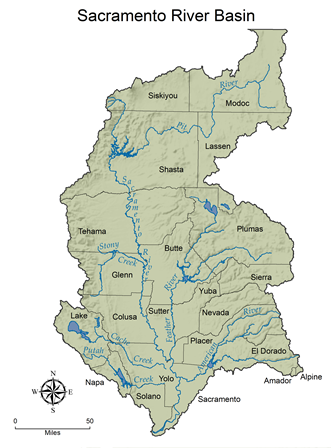
SWAMP - Sacramento River Basin
Quick Links
Sacramento Watershed Coordinated Monitoring Program
The Sacramento Watershed Coordinated Monitoring Program (SWCMP) is a coordinated effort between the Central Valley Water Board and the Department of Water Resources (DWR) Northern Region to monitor water quality trends in the Sacramento River Watershed. Coordinated monitoring was initiated in the fall of 2008 at 41 sites along the Sacramento River main-stem and at the lower end of tributary streams. In 2011 three sites were added in the upper Feather River Watershed and in 2014 twelve additional mid-elevation sites were added along key tributaries, for a total of 56 monitoring stations. Eleven stations are located to coordinate with SWAMP's statewide Stream Pollution Trends Monitoring Program, a study to monitor contaminant trends in sediment. Overall water quality assessments will benefit from the added value of both monitoring programs.
- Monitoring Plan
- Quality Assurance Project Plan
Harmful Cyanobacteria Blooms
In 2011 the University of California, Santa Cruz completed a study on harmful cyanobacteria blooms in Clear Lake and the Sacramento-San Joaquin Delta. The goal of the study was to monitor the distribution of harmful cyanobacteria and their associated toxins.
- Final Report
- Monitoring Plan
- QAPP
- Achievement Report
Pyrethroid Pesticides in the American River
SWAMP funded a University of California, Berkeley study to investigate sources of pyrethroid pesticides to the Lower American River. Monitoring was conducted during three storm events in 2009 and 2010.
- Final Publication
- Monitoring Plan
- QAPP
Past Monitoring and Assessment Efforts
- Lower Sacramento Sub-watershed
Multiple studies have been conducted looking at urban and agricultural impacts on water quality in the Lower Sacramento using sediment toxicity, water column toxicity and bioassessment as indicators. Reports from these studies are available on SWAMP Water Quality Reports. - Upper Feather River Watershed
SWAMP-funded monitoring was conducted from October 2000 to December 2003 under the direction of the Feather River Coordinated Resource Management Program. The monitoring program included 26 sites (in a 3,000 sq. mi. watershed) where continuous recording and discrete samples and measurements were taken. Monitoring parameters included stream flow, channel morphology, aquatic habitat quality, chemical/physical/biological water quality constituents, macroinvertebrate and fish populations.- Report: Feather River Coordinated Resource Management Watershed Monitoring Program
- Pit River Watershed
SWAMP-funded monitoring was conducted in the Pit River watershed from 2001 to 2005. The program was started by the Central Valley Water Board and is now under the direction of the Pit River Alliance (www.pitriveralliance.net), a collaborative group of resource agencies, landowners, private industry, and resource advocates. The Pit River is currently 303(d) listed for temperature, nutrient loading, and low dissolved oxygen. Monitoring included stream flow, various water quality constituents (consistent with the requirements of the Ag Waiver program), channel morphology and habitat measurements, and macroinvertebrate populations. In 2001 and 2002, monitoring was conducted at eight sites on the main stem of the Pit River. In 2003, monitoring was expanded to include four additional main stem sites and 33 tributary sites.- Report: Pit River Water Quality Study: 2001-2002
- Report: Pit River Water Quality Study: 2003-2005
SWAMP funded additional monitoring in the Fall River watershed from 2003 to 2005. The Fall River Resource Conservation District and the Pit River Watershed Alliance monitored flow and various water quality constituents, consistent with the requirements of the Ag Waiver program, at twelve sites. In 2005, SWAMP funded a UC Davis study on aquatic weed conditions and macroinvertebrate populations in Fall River.- Report: Fall River Water Quality Report: 2003-2005
- Report: Fall River 2005 Macroinvertebrate and Channel Cross Section Monitoring
- Cow Creek Watershed
From 2001 to 2003 Central Valley Water Board staff conducted water quality monitoring at 16 sites in the Cow Creek watershed. Monitoring included flow, physical parameters, bacteria, and macroinvertebrates. Cow Creek is a major, undammed tributary to the Sacramento River. The watershed has significant anadromous fish resources, resident cold-water fish species, and substantial recreational use. Three of the five principal sub-watersheds are currently 303(d) listed for elevated fecal coliform levels.- Report: Cow Creek Water Quality Study: 2001-2003




